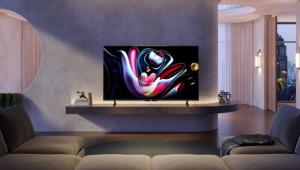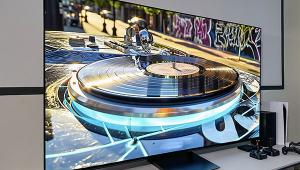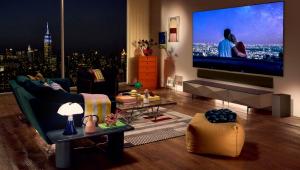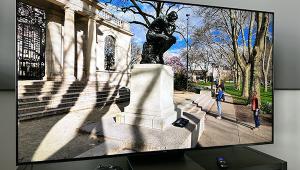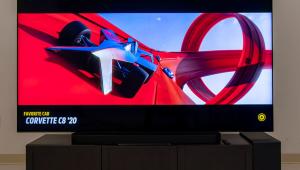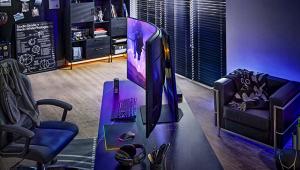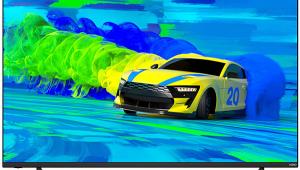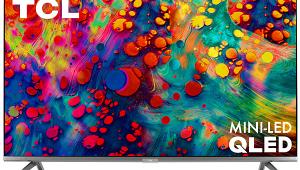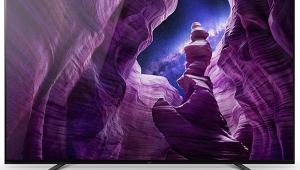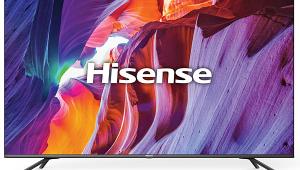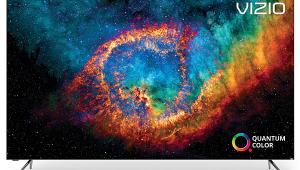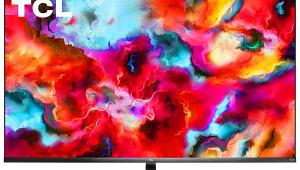Seems like a work in progress..
Vizio RS65-B2 LCD Ultra HDTV Review Vizio RS65-B2 Soundbar Audio System
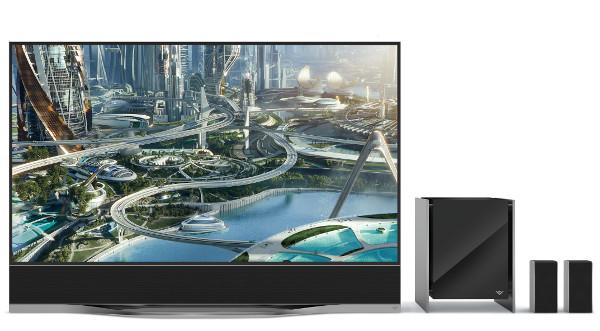
J The set and soundbar are linked by a (provided) HDMI cable attached to the RS65-B2’s ARC-capable HDMI 1 port. The subwoofer receives the bass and surround information wirelessly, and the amps for the sub itself and surrounds are in the subwoofer. The surrounds use a wired connection to the subwoofer, and long speaker cables are included with required RCA plugs (!) on either end. (No audiophile would choose cables this thin, but for the small, modest surround speakers here they’re likely adequate.)
The soundbar includes a 4.5-inch woofer and 1-inch tweeter for each of its three channels. The surrounds each include a 3” woofer and 0.75-inch tweeter. The soundbar and surrounds are both sealed and their grilles are not removable.
The sides of the 10-inch subwoofer are metal plates offset from the cabinet itself by roughly an inch. Inspection with a flashlight revealed that the subwoofer driver is positioned behind one of these plates, and that there’s a large passive radiator of unspecified size on the other side. Vizio gives no specs for the subwoofer or soundbar power, either.
All of the controls for this system are in the TV’s Audio menu. These include Bass, Treble, Center (level), Balance (L/R front), Surround Balance, Surround Volume, Subwoofer (level), and Advanced Audio. The latter includes TV Sound Bar (On/Of), Surround Speakers (On/Off), Volume Leveling, Subwoofer Pair (for reconnecting the wireless sub), Audio Channel Check, and Reset Sound Bar. The overall volume level for the system is set by the Volume control on the TV remote. Audio Channel Check provides voice ID of each channel, but no test tones for setting their levels. You’re on your own to do that manually, likely by ear (as I did).
I didn’t use the Volume Leveling feature, except to try it out. It’s based on DTS’ TruVolume technology, and achieves its purpose: compressing the dynamics to minimize the peak volume level for late night viewing (or avoiding the wrath of unsympathetic neighbors!). With it off, I found that my large room demanded very high settings on the main Volume control to satisfy my need for speed (85-95 out of a maximum of 100). But the system handled this without obvious strain or distortion. The sub could misbehave, however, if balanced too high in level.
I set up the soundbar just below (but not attached to) the RS65-B2 display. This put it about a foot and a half off the floor and, like the set, well forward of the wall behind it. Positioning the soundbar on or near a wall (which will likely be a more typical setup but not possible in my room) would likely fatten the midbass noticeably. This wouldn’t necessarily be a good thing. But the near-floor location I used will also affect the mid-bass, though perhaps to perhaps to a slightly different degree. After I reduced the Bass control by several steps to compensate for this, the mid-bass balance was generally good and only slightly too prominent on occasion with male dialogue. Some sort of graphic equalization might have been even more targetable and effective for these near-boundary situations, but the Vizio doesn’t offer this.
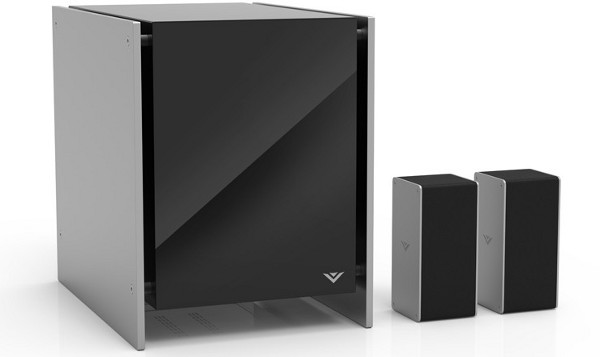
The subwoofer was positioned to the right of the set (not in the back of the room as Vizio’s manual suggests). The surrounds were located on bookshelves, about three feet behind the seating area and above ear height, which did require a long speaker cable run from the sub to the surrounds .
Performance
With one or two challenging sources (such as the rampaging waterfall at the beginning of Prometheus) I heard slight crackling noises in the soundbar’s left channel, but the center or the right were fine. I suspect a slightly out-of-spec driver or amp on that channel, but in this noise was otherwise a very rare occurence.
I can’t say I was floored by the overall performance of the RS65-B2’s sound system; I’ve heard far too much exceptional audio, in my own setup and elsewhere—and far too few soundbars—to go that far. But I will say it surprised me. I expected it to leave in the dust other set-specific TV audio systems I’ve experienced, and it did that without breaking a sweat. What I didn’t expect was that, after a few minutes of adaptation (for movies in particular, more so than for two-channel music) it often surprised me by how well it kept me engaged in the overall experience—and how it rarely detracted from it. I watched all or more of several movies on Blu-ray and a lot of talking heads and sports on cable, and from my slightly off-center seat, about 10 feet from the soundbar, the midrange never sounded wrong or obviously colored (apart from that subtle but only occasional trace of extra warmth on male vocals).
The subwoofer provided a solid foundation to both music and movies. But like any small subwoofer it can run into trouble of you ask too much of it. Turn it up too loud and it can go boomy on you. Go higher and it might burp in protest. Admittedly my large home theater space didn’t do it any favors, but fortunately I got respectable results and minimized both of these issues by simply cutting its output level by a few decibels.
Balanced at what would normally be the correct subjective level, or even slightly lower, the surrounds sounded overly prominent and fizzy. I had to position them higher, angle them away from the listening position, and turn them down dramatically to keep them from being more of a distraction than a plus.
The top end of the soundbar was a bit of a chameleon. When seated at direct center listening to 2-chanel music, it was a bit bright, depending on the volume. But when I moved off to the side where I normally sit while watching movies, the sound was open and surprisingly spacious. I wouldn’t call it airy, but neither was it dull or edgy. And the cohesive soundscape it produced (almost!) compensated for the limited stereo separation and imaging common to soundbars.
With the Vizio’s audio system operating nearly full tilt I watched Master and Commander: The Far Side of the World for the first time in years. The punch of the orchestral drums, the explosiveness if the cannon fire, and the sweetness of the strings as the ship’s surgeon and Captain Aubrey play their violin and cello in the Captain’s cabin were all fully convincing. Ant-Man was equally absorbing in a very much less, um, real-world way, as ex-con Scott Lang bounces in and out of that film’s intriguing, miniature landscapes.
I also listened to several audio-video multichannel music Blu-rays. An old favorite, Legends of Jazz, is a concert by a wide range of talented artists, among them Chris Botti on trumpet, Jan Monheit accompanied by John Pizzarelli on guitar, Clark Terry, Ramsey Lewis, and others. Within the limits described above, they all sounded impressive. So did another Blu-ray in a different genre altogether: the 2014 New Year’s Concert of the Vienna Philharmonic. It’s a spectacular sounding (and looking!) disc, and Vizio system didn’t disappoint. It provided a solid foundation, including the bass drum, and displayed in a compelling fashion the gorgeous sound of one of the world’s best orchestras, playing in the rich acoustics of its home venue, the Vienna Sofiensall.
Would I use the RS65-B2’s audio system as my primary music/movie workhorse? Probably not, but as noted earlier I’m spoiled by better (and pricier) gear. A modest $1000 system (2-channel) might give the Vizio a run for its (your!) audio money, assuming it was available separately. But if the Vizio RS65-B2 UHDTV is on your wish list, its tag-along sound system might well command your respect. It did mine. —TJN
- Log in or register to post comments


Should a TV, a TV, something bought for image quality, really receive a Top Pick when it has such faults? Have we so lowered our expectations due to a lack of truly high performance displays?

I would think most people dumping six grand into their set would have a nice home theatre sound setup of their own. Maybe it's just me.

384 zones for the vizio... Seeing the backlight for the new Sony Master Drive set made me realize that all we need to do is create a direct white led display with a resolution of 720*480 and slap filters, diffusers, etc and the LCD panel. With a 480p direct led display each pixel is controlled individually and boom! Best LCD ever!
Ideally.. I would love to see an ILED... Inorganic LED Display!

Input lag measurements have become very important in modern TV reviews. Use of a Leo Bodnar input lag tester should be part of standard measurement equipment and only takes about 20 seconds to plug in and measure.
Do you have plans to add input lag measurements to your reviews?

